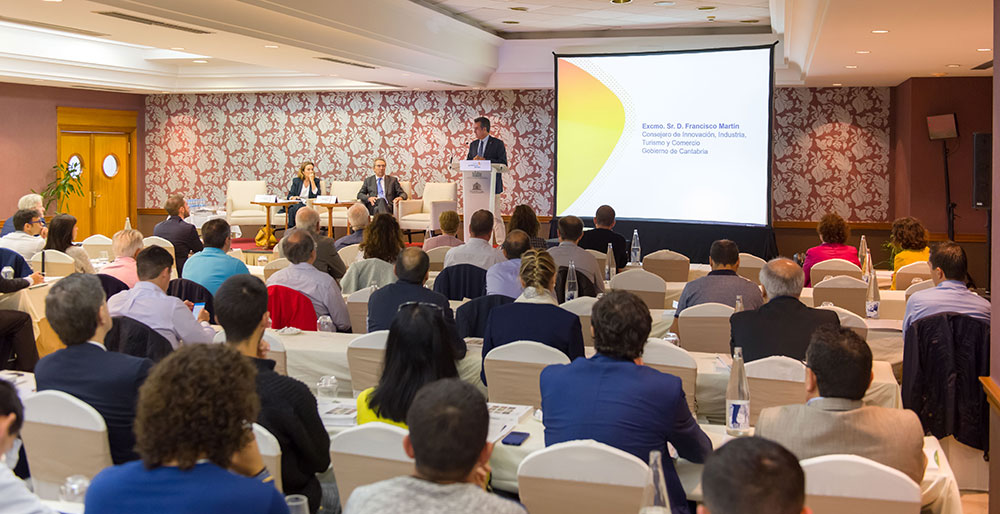The keys to building smart cities: more energy efficiency, greater urban mobility and more sustainable economic activities
At the seminar organised by the Gas Natural Fenosa Foundation in partnership with the Regional Government of Cantabria, various experts examined “smart” experiences in such cities as Santander, Logroño, Malaga and L’Hospitalet de Llobregat (Barcelona).

Earlier today in Santander, the Councillor for Innovation, Industry and Trade of the Regional Government of Cantabria, Francisco Martín, the Mayor of Logroño and Vice-President of the Spanish Network of Smart Cities (Spanish acronym: RECI), Concepción Gamarra, and the General Manager of the Gas Natural Fenosa Foundation, Martí Solà, opened the seminar entitled Smart Cities: assessment of and practical cases in energy efficiency. During the course of the event, which was attended by around 100 professionals, various experts presented indicators and ways to assess smart cities and analysed the service digitalisation experiences of four Spanish cities: Santander, Malaga, Logroño and L’Hospitalet de Llobregat (Barcelona).
In the last decade, many cities around the world have made a digitalisation effort (this understood as advanced automation and connectivity) with many public and private services in order to also achieve greater satisfaction among inhabitants and greater respect for the environment. Such places are now being referred to as “smart cities”. However, according to the General Manager of the Gas Natural Fenosa Foundation, Martí Solà, “we still lack a way to assess the results, we have no system of indicators and measurements that is internationally accepted and capable of comparing progress between one and another to draw up rigorous rankings that stimulate innovation.”
In the first part of the seminar, two systems of indicators and ways to assess smart cities were presented; one created by Rudolf Giffinger at the Technology University of Vienna, and the other designed by two Spanish engineers and professors at the School of Civil Engineering at UPM: Rosa María Arce and Concepción Moreno. They explained that, “to achieve this new urban paradigm, city transformation projects are mainly targeted at improving energy efficiency and the consumption of natural resources, improving mobility, fostering the development of green economic activities and deploying mechanisms for citizen engagement and local e-government.”
In turn, the study director from the Technology University in Vienna, Rudolf Giffinger, said that, “in the current context of socioeconomic crisis and environmental problems, the debate should be focused on the challenge of how cities can reduce energy consumption and emissions while improving quality of life and sustainable development.”
The Smart Client Innovation Manager at Gas Natural Fenosa, Milagros Rey, presented two practical cases in the development of smart cities on which the power company has been involved: STARDUST and GrowSmarter. The first, STARDUST, is a European project involving Pamplona, Trento and Tampere. It is funded under the EU’s Horizon 2020 programme with a budget of 21 million euros and is aimed at encouraging the path towards low-carbon emission cities that are highly efficient and smart with a citizen-focused approach. The second, GrowSmarter, is a European initiative being undertaken in Barcelona, Cologne and Stockholm to encourage sustainable cities through smart solutions.
Innovative experiences in four Spanish cities
The Mayor of Santander, Gema Igual, presented an overview of the strategy implemented by Santander as a smart city, where energy is one of the most important pillars. This is demonstrated by “the council’s commitment to energy efficiency projects, both at a city-wide scale where the results from an ongoing street lighting project have been highly positive and at smaller scales through such European projects as EMPOWER or NETFFICIENT”.
The Mayor of Logroño and Vice-President of the Spanish Network of Smart Cities (RECI), Concepción Gamarra, said that, ever since the Smart Cities Network was set up in the regional capital of La Rioja in January 2012, “we have been working every day to gradually switch from a management model based on public spending to another based on an economic policy with more collaboration between public and private initiative.”
The Deputy Mayor and Councillor for Innovation and New Technologies of Malaga City Council, Mario Cortés, explained that Malaga approved an Action Plan for Sustainable Energy (Spanish acronym: PAES) that set a target to reduce emissions in the city by 20% before 2020. Furthermore, the City Council joined the new European Covenant of Mayors for Climate and Energy initiative in December 2015, with new emissions reduction targets of 40% for 2030. As a result, the city of Malaga “is seeing a series of smart projects in the field of energy efficiency that are undoubtedly in line with achieving those targets”, he said.
The Deputy Councillor for the Environment and Sustainability at L’Hospitalet de Llobregat Council, Rafael Jiménez, presented two projects developed in the Catalan city. One is the Carbon Footprint Indicator (“L’HEC” in Catalan), a finalist at the 2015 World Smart City Awards, which “will allow the carbon footprint of buildings in our city to be analysed and their impact to be calculated over the next 10 years”. The second project relates to the implementation of a self-consumption solar power system for a unique building in the city, which will lead to an estimated saving of €18,153/year.
Share